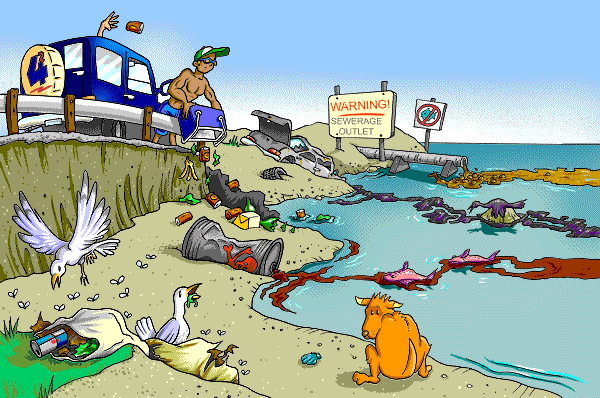Water pollution may be defined as the contamination of water with some foreign materials that can adversely affect human beings or make it unfit for use. The water present at the surface of earth is never pure. It always contains small quantities of suspended particles, organic and inorganic substances and a number of micro-organisms such as bacteria, virus, fungi, algae, and protozoa etc. When concentration of these substances increases in water, the water becomes unfit for use and we say that water has become polluted.

Use of polluted water is harmful for human beings, animals and plants. The unwanted and harmful substances which pollute the water are called water pollutants.
Characteristics of Potable Water
Water is very important for human beings. So, the water used by human beings for drinking purpose should have following characteristics.
- It should be transparent, colourless and odourless.
- It should be pleasant in taste.
- It should be free from disease causing micro-organisms and objectionable chemicals.
- It should contain sufficient amount of dissolved oxygen.
Prevention and Control of Water Pollution
1. To prevent water pollution, domestic sewage should be chemically treated to make it non-toxic.
Treatment of Domestic Sewage
The treatment of domestic sewage involves three steps. These are:
- Primary Treatment:- In this step, domestic sewage is passed through screens and settling tanks to remove large lumps of solid matter. Primary treatment does not remove pathogens, organic matter and minerals present in domestic sewage.
- Secondary Treatment:- In this step, sewage is sent into a chamber called Upflow Anaerobic Sludge Blanket (UASB). Here the anaerobic micro-organisms decompose the complex organic compounds into simple compounds. The sewage is then filtered and chlorinated to kill the pathogens present in it.
- Tertiary Treatment:- In this step, the sewage is made pure enough to drink. This is done by additional filtering and chemical treatment of sewage to remove its minerals contents.
2. Plastic containers, polythene bags, waste food materials and waste papers should not be thrown into water sources.
3. Excessive use of fertilizers and detergents should be avoided.
4. Strict laws should be enacted by government to make it obligatory for industries to treat the waste water before discharging it into water sources.
Test Your Understanding and Answer These Questions:
